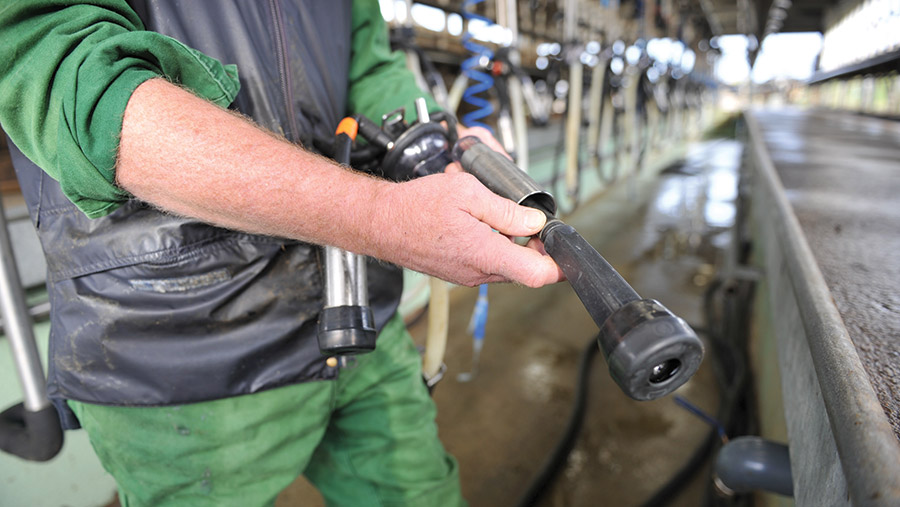How to make sure your parlour is running properly

Poorly serviced, maintained and operated milking machines can result in inefficient or incomplete milking, poor milk quality, teat trauma and mastitis infections.
With herd sizes increasing and parlours operating for longer, an annual service by a dairy engineer is no longer sufficient.
Udder health vet Tom Greenham advocates a series of checks to prevent unplanned breakdowns and damage to sensitive teat tissue.
Some checks must be carried out daily, others just once a year, but they are vital to ensure the machine is functioning correctly.
See also: How to calibrate dairy parlour feeders and cut costs
“Without these checks, there is a risk that milk quality will suffer, because if the machine isn’t cleaning correctly, the bactoscan results will be high,’’ says Mr Greenham, of Advance Milking.
Udder health will be compromised, too, with an increased incidence of mastitis and higher somatic cell count levels due to the negative impact of the machine on teat health and bacterial challenge.
Most important of all is checking the end results of milking, he says. “Check that cow behaviour is normal and that teats appear normal at cluster detachment.”
Also, check milking performance parameters, including milk volume per hour, cows milked per hour and milk flow data, if available.
Below, Mr Greenham advises what checks should be carried out to keep your parlour in tip-top condition.
Daily checks
- Cluster air-bleed holes should be open and unobstructed
- If claw-piece bowls are flooded, this is a sign of inadequate air intake; transparent bowls facilitate this check
- Check whether milk/wash fluid is present in the long pulse tubes, again this is easier if the tubing is clear silicon; if fluid is present then check for split liners in that cluster
- Open the drain in the air pipeline and check the volume of fluid that drains out; large volumes may indicate a split liner or leaky valve between the “milk side” and the “air side” of the plant
- Check all short milk tubes and short pulse tubes for splits at the folding region of the tube
- Assess all shells and claw-pieces for cracks
- Monitor the vacuum level at start of milking – before the cows are in the parlour – and during milking. Target vacuum will be established at the annual dynamic test
- Check whether the pulsation is active at each milking point by observing movement of the cluster on the udder
- Check the cluster positioning on the udder, correcting ACR cord length or long tube position, if necessary
- Listen for air leaks throughout the pipework.
Weekly checks
- Check the inside of the bulk tank for build-up of milk residues
- Check the vacuum pump oil levels
- Check the air intake filters at the pulsators and vacuum regulator, and clean or replace, if necessary
- Check jetter nozzles are undamaged and open and unobstructed
- Check that milk lines are not knocked out of the correct angle needed for draining
- Break down the receiver jars, weigh these and clean the fittings and gaskets
- Review bactoscan results each week to assess cleaning success.
Monthly checks
- Disassemble and clean the pulsators
- Disassemble and clean vacuum regulators and replace air filters
- Check cleanliness of the air pipeline and flush with cleaning fluid, if necessary
- Check the condition of air tubes, the long pulse tubes and the long milk tubes
- Wash the sanitary trap and check the float is moving freely
- Review mastitis and cell count results.
Six-monthly checks
- Evaluate the entire milking system with a static test and a parts service
- Replace all pulsator rubber parts, hoses and air tubes
- Replace all long milk tubes
- Replace the gasket in the receiver jar
- Check the belt tension of the vacuum pump.
Annual checks
- Conduct a dynamic test, which involves testing the plant during milking and assessing the milking routine, to evaluate the interaction between the milking machine, cows and the milking team
- Based on the results of this test, review the machine settings and milking targets.
Advice on changing liners
Milking liners need changing regularly because liners age as they open and close and because they come into regular contact with milk fat and stringent cleaning products.
Aged liners will milk more slowly, be more prone to slippage and leave higher levels of residual milk in the udder.
Two key checks to carry out:
- Check the inside of the liners to highlight any clusters that are not washing well
- Check the alignment of the liner within the shell to ensure liners are not mounted twisted.
